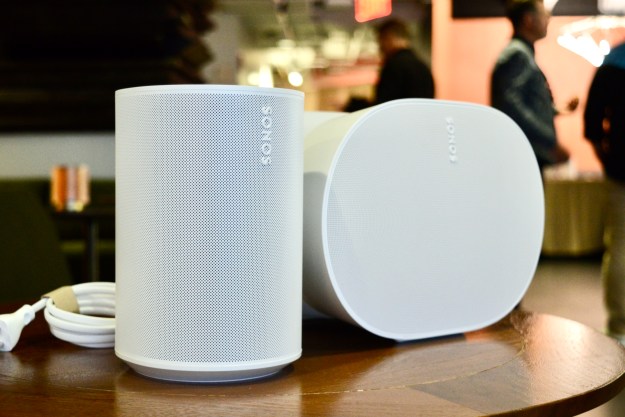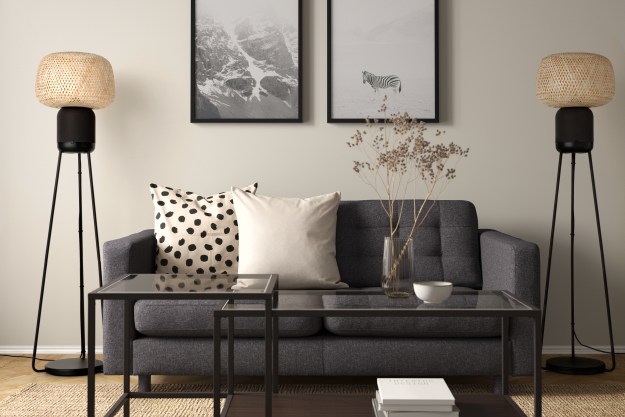Slowly but surely, Urbanears is making waves as an innovator in the audio world.
Thanks to single-cable support for quarter-inch and 3.5mm outputs, the company’s Zinken headphones plug into smartphones as easily as synthesizers and headphone amps. And Urbanears’ Sussen adapter sends two audio streams via a single headphone cable — an industry first. Innovation is in keeping with the company’s philosophy, and it’s what lead to the development of its new multiroom wireless speaker line, called simply Connected Speakers.
Norra Norr and Zound Industries founded Urbanears in 2009 with the goal of making “passionate” products that don’t compromise on “human centered” design. “We look at how we can solve problems in people’s lives,” said Urbanears creative director Oscar Axhede at the Connected Speakers launch event in New York City. “When we set out to make a new product, we look to see if there’s anything interesting for us to add.”
Urbanears didn’t originally plan on making a multiroom wireless home speaker system at all. “We didn’t think it was super interesting,” Axhede said. But the way the Sweden-based company tells it, customers practically demanded it. “They gave us a lot of insights about why they didn’t like their speaker,” he said. “We thought there was something we could do.”
So the Urbanears team got to work, spending two years designing its minimalist new models, including the smaller Stammen ($350), and the flagship Baggen ($450). The rectangular speakers were specifically designed for simplicity and ease of use, addressing three pain points for the genre: Lack of support for standards like Google Cast and Apple AirPlay, the absence of simple playback controls, and disappointing sound performance.
The team settled on a simple solution to the “standards” problem: Support all of them. Both Connected Speakers boast built-in support for Wi-Fi streaming, including Google’s Cast Audio, Apple AirPlay, and Spotify Connect, alongside Bluetooth connection and a wired input.
“There’s a format war — a lot of companies are trying to protect their own world,” Axhede said. “True to our Swedish roots, we decided to be neutral.”
Solving the second pain point — on-speaker controls — was a bit more complicated. The team wanted nondescript buttons that could handle basic functions, but didn’t want to compromise on the Connected Speakers’ minimalist vision.
“We initially thought adding buttons would go one step forward and two steps back in terms of design,” he said. “There has to be a balance.”
The novel compromise? A knob with presets programmed via the Connected Speakers companion app. When you load up the Connected Speakers app for the first time, you’re prompted to assign radio stations, playlists, or individual albums to each of the Connected Speakers’s presets. In the future, when you turn said knob to a preset you’ve set, it’ll begin playing immediately — no smartphone required.
A second knob adjusts volume and pauses the playing track when pushed. “It’s a very easy, very tactile way of working with speakers,” Axhede said.
Solving the final issue — disappointing sound — naturally came down to old fashioned acoustic design. The engineering team packed the company’s flagship model, the Baggen, with a 6.5-inch woofer powered by 50 watts, and two 16mm 20-watt tweeters, while the transparent fabric screen at the front aims to let sound flow unimpeded. An EQ feature inside the app also allows users to control basic treble and bass levels.
As mentioned, the new Connected Speakers also support multiroom audio in the vein of Sonos, DTS Play-Fi, and other systems. The system can support up to five Connected Speakers at a time, and switching between them is easy: A tap of the volume knob swaps between single-speaker Solo mode and Multi Mode, while a forthcoming update will add support for pairing two Connected Speakers in stereo.
At the launch event, Urbanears engineers treated us to a wide selection of musical genres across its speaker line with impressive results. The speakers made light work of the different instrumental sounds, showcasing the distinctive twang of an acoustic guitar track, the buzzing bass line of Swedish electronica, and the ethereal synth tones of ambient house music.
Generally speaking, the Connected Speakers handled the music with ease. Bass occasionally got the better of the highs and mids, but that’s a balance issue — crucially, the treble and midrange registers were crisp, clear, and free of distortion. The speakers also get quite loud. At a little past half volume, a single speaker was easily audible from the other end of the loft-like demo space — even above the drone of side conversations.
“They’re speakers made for humans,” Axhede said. “There aren’t many speakers in most people’s homes. The ones they do have should be easy to work with.”
Urbanears’ new Connected Speakers are available starting March 30 in a variety of stylish colors, including Dirty Pink, Vinyl Pink, Plant Green, Concrete Grey, Goldfish Orange, and Indigo Blue. You can check them out now at the company’s website.
Editors' Recommendations
- Samsung’s new Dolby Atmos wireless speaker doubles as a picture frame
- New Klipsch tabletop wireless speakers are a more affordable, capable take on mid-century modern
- Skullcandy’s new Bluetooth speaker lineup boasts big battery life for $30 to $80
- Niche Canadian company takes on Sony with new wireless earbuds and headphones
- Pantheone’s Obsidian smart speaker puts Alexa in a sharp new body


